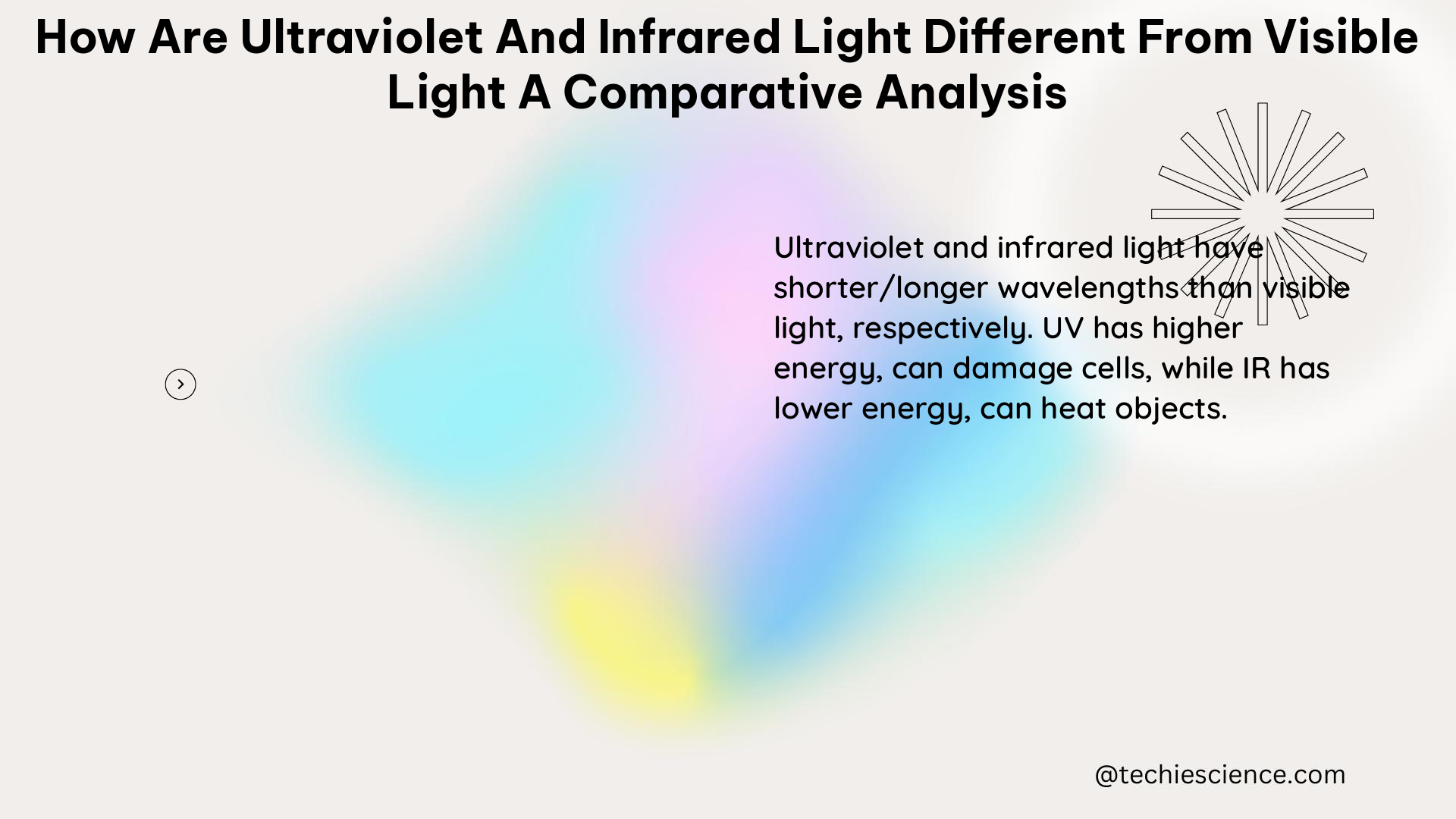Ultraviolet (UV), infrared (IR), and visible light are all forms of electromagnetic radiation, but they differ significantly in their wavelength, energy, and impact on materials and the human body. This comprehensive guide delves into the intricate details of these light spectra, providing a deep understanding for physics students and enthusiasts.
Wavelength: The Spectrum Unveiled
The visible light spectrum, which is the only range of electromagnetic radiation that the human eye can perceive, spans from approximately 400 nanometers (nm) to 700 nm. In contrast, ultraviolet light has shorter wavelengths, ranging from 100 nm to 400 nm, while infrared light has longer wavelengths, extending from 700 nm to 1 millimeter (mm).
To quantify these differences, we can use the following data points:
- The UV spectrum is typically divided into three categories: UVA (315-400 nm), UVB (280-315 nm), and UVC (100-280 nm).
- The sun emits UV light with a peak intensity at around 300 nm.
- The Earth’s atmosphere absorbs most of the UVC and some of the UVB radiation from the sun.
Energy: The Inverse Relationship

The energy of light is inversely proportional to its wavelength, as described by the formula E = hc/λ, where E is the energy, h is Planck’s constant, c is the speed of light, and λ is the wavelength.
- The energy of a photon of UV light at 300 nm is approximately 4.13 electron volts (eV).
- The energy of a photon of IR light at 1000 nm is approximately 1.24 eV.
This means that UV light has higher energy levels than visible light, while IR light has lower energy levels. This difference in energy has significant implications for the interaction of these light spectra with materials and the human body.
Impact on Materials: Degradation and Heating
The varying energy levels of UV, IR, and visible light have distinct effects on materials:
- UV light can cause materials to degrade, discolor, or undergo photochemical reactions. For example, UV light can cause fading in textiles, discoloration in plastics, and weakening in certain types of rubber.
- IR light, on the other hand, can cause materials to heat up, leading to thermal expansion, distortion, or even melting in extreme cases.
These effects are crucial to consider in various applications, such as the preservation of artwork, the design of outdoor equipment, and the development of materials for specific environments.
Interaction with the Human Eye: Visibility and Potential Damage
The human eye is uniquely adapted to perceive visible light, with peak sensitivity at around 555 nm. However, the interaction of UV and IR light with the eye is quite different:
- Visible light is the only form of light that can be detected by the naked eye.
- UV light is not visible to the naked eye, but it can cause damage to the cornea and lens, leading to conditions such as cataracts or macular degeneration.
- IR light is also not visible to the naked eye, but it can cause discomfort or even burns to the eye, especially at high intensities.
To quantify these interactions, consider the following data points:
- The human eye can detect light with wavelengths between 400 and 700 nm.
- The cornea absorbs UV light with wavelengths shorter than 290 nm, while the lens absorbs UV light with wavelengths between 290 and 400 nm.
- The retina can detect light with wavelengths up to around 700 nm, beyond which it becomes increasingly insensitive.
Applications: Diverse Utilization
The unique properties of UV and IR light have led to a wide range of applications:
- UV light is used in various applications, such as sterilization, curing of coatings, and fluorescence imaging.
- IR light is used in applications such as thermal imaging, night vision, and heat sensing.
These applications leverage the specific characteristics of each light spectrum, demonstrating the versatility and importance of understanding the differences between UV, IR, and visible light.
Conclusion
In conclusion, the comparative analysis of ultraviolet, infrared, and visible light reveals their distinct characteristics in terms of wavelength, energy, impact on materials, interaction with the human eye, and diverse applications. This comprehensive understanding is crucial for physics students and enthusiasts to navigate the complex world of electromagnetic radiation and its practical implications.
Reference:
- The Effects of Ultraviolet and Infrared Radiation on the Eye
- Understanding Infrared Light
- Agent of Deterioration: Light, Ultraviolet and Infrared

The lambdageeks.com Core SME Team is a group of experienced subject matter experts from diverse scientific and technical fields including Physics, Chemistry, Technology,Electronics & Electrical Engineering, Automotive, Mechanical Engineering. Our team collaborates to create high-quality, well-researched articles on a wide range of science and technology topics for the lambdageeks.com website.
All Our Senior SME are having more than 7 Years of experience in the respective fields . They are either Working Industry Professionals or assocaited With different Universities. Refer Our Authors Page to get to know About our Core SMEs.